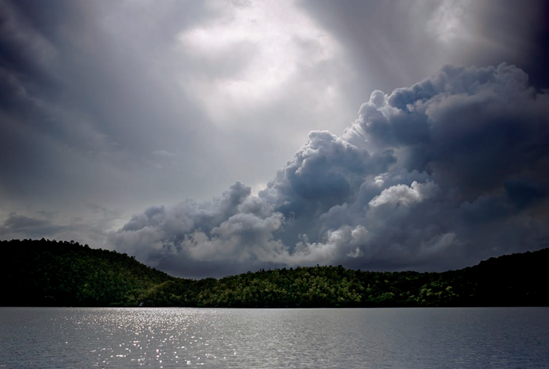Next to people, landscape and travel rank among the most popular photographic subjects. But as evidenced by many people's vacation pictures, it isn't easy to shoot a great travel image. The human eye tends to view scenes selectively, but the camera simply records the entire picture, often with disappointing results. Being in a great locale also contributes to the experience — you may be enthralled with the sound of a trickling stream or the fragrant aroma of spring flowers in the mountains. The challenge is how to capture the essence of a travel destination and the feeling that goes with it. Scenic photography takes a lot of devotion, patience, and practice (and as some of the following photographers attest, a certain amount of serendipity). The essence of a great scenic image is to zero in on — and convey — what grabbed you about the scene in the first place.
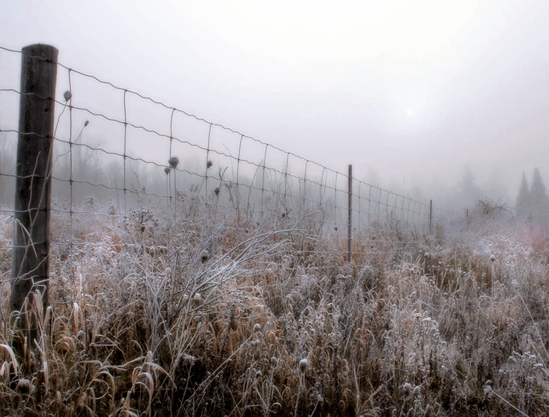
"Foggy, Frosty Morning"
© Wendy Stevenson
Oxford Station, Ontario, Canada www.intoitphotography.com
Bright, sunny days are great for capturing postcard-type landscape shots, but sometimes less than perfect weather can really help you interpret the essence of a place. Fog offers a lot of atmosphere and has a way of obscuring distracting elements in a scene. In this image, the focus is on the frost covering the foliage in the foreground. On a sunnier day, the background may have been more visible, making the scene a little busier. As this image illustrates, the farther an object is from the camera, the more it seems to dissolve into the misty background. When you're shooting on a foggy day, exposure can be a challenge. Because fog is very reflective, it has a tendency to fool your light meter into causing underexposure. You can compensate for this by opening your aperture one stop above the meter's reading.
"On my way to work one morning, I stopped at an intersection and saw this most beautiful scene. What caught my eye was the way the white frost and cloudy sky seemed to make the fall colors of the long grass pop! The fence had a nice rustic look and was leading toward the diffused light of the cloud-covered sun. It was just as though it was all set up for me."
Canon EOS Digital Rebel XT
Canon EF-S 17–55mm f/2.8 zoom lens set at 21mm
1/20 of a second at f/22
ISO 100
Ambient light on a foggy day

"Salinas Ruins"
© Eric Williams
Albuquerque, New Mexico http://eric_williams.photoworkshop.com
These ruins — standing tall and glowing in lingering afternoon light — provide a beautiful contrast to the blue sky. And the rising moon makes this image especially intriguing. (To get a successful moonrise, you may find that you want to combine two images in Photoshop to get the best results, particularly if you want a large moon with detail.) Late in the day, the long shadows cast by the sun emphasize the three-dimensionality of a landscape. The light rakes across the land, which enhances texture dramatically. Many photographers, as this one did, plan their landscape shots well in advance to capture events like a lunar eclipse. You may also want to do a little scouting for locations ahead of time. As late afternoon turns into dusk, the sky takes on a colorful, rapidly changing light. You need to work quickly before the sun goes down if you want to capture the beautiful light of the magic hour. Because the light is increasingly becoming dimmer, use a tripod and cable release to avoid camera shake during long exposures.
"On the evening I took this picture, there was going to be a partial lunar eclipse that would occur around sundown. The moon was supposed to rise around dusk, so I thought that this would make a very interesting shot with the moon rising over the ruins in the evening."
Canon EOS Digital Rebel XTi
Canon EF 17–40mm zoom lens set at 17mm
1/40 of a second at f/7.1
ISO 100
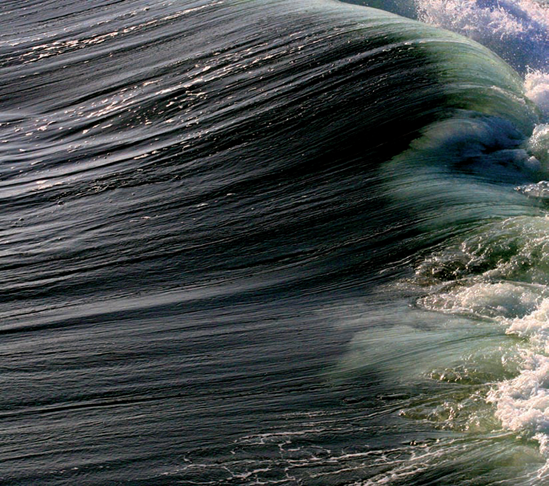
"FoldoverBlues"
© Robyn Raggio
Oxnard, California www.raggiovisio.com
This image makes a statement about the beauty and power of the sea. The smooth blue green of the water is a great contrast to the crisp spray as the wave breaks onshore. The best time to photograph the surf is at high tide, when the sea is most volatile. Using a moderate telephoto lens, as the photographer did here, allows you to isolate a single wave as it crashes onto the shore. A fast shutter speed (1/250 second or greater) freezes the spray, but timing is very important. You need to click the shutter an instant before the wave breaks to catch it at its peak. A motor drive or Sports/Action setting on your camera allows you to fire off several frames in rapid succession, thus increasing your chances for success.
"The waves call to me every morning... 'Come and see! Come and see!' I walk to the pier and up and over the chaotic liquid as the sun rises, the clouds and fog contain the light and throw it onto the sea. Some days red, some days purple, some days pink, but those special days are aquamarines and rich cobalts, boiling under the surface like a frantic painter's palette, the surface remaining as smooth and silken as a maiden's hair. I hover and shoot, spellbound by the show that lasts only a few minutes, then is gone forever. Yet I feel no sorrow for the passing of the moment, for I know I have captured the day's performance — snug and safe in a little black box."
Canon EOS 5D digital SLR
Canon EF100mm f/2.8 macro lens
1/500 of a second at f/22
ISO 1250
Natural light
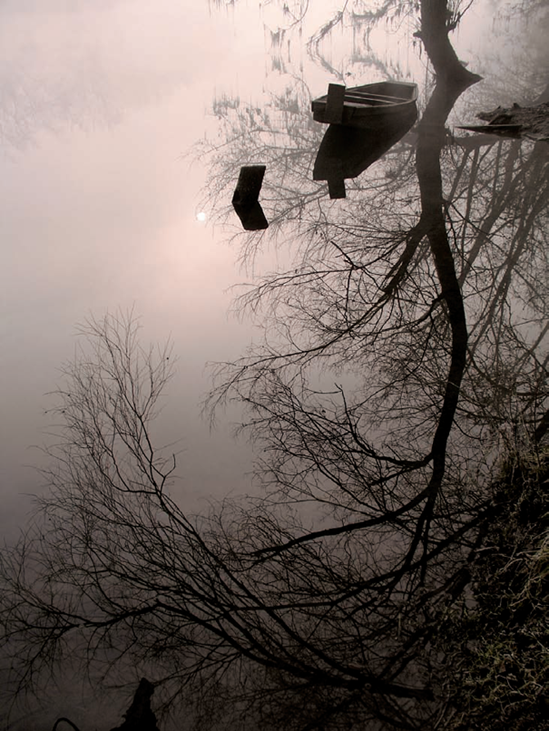
"Land of Wistful"
© Aleksandra Podrebarac
Karlovac, Croatia www.alexartphoto.com
Painters and photographers throughout the years have presented water as a prominent source of reflections, as it offers more possibilities than other reflective surfaces. This image has a very painterly feeling, and evokes a sense of mystery and romance. The smooth surface of this water mirrors the environment perfectly. Perhaps the best time to find glass-smooth water like this is just after dawn, before the sun warms up the air and breezes begin.
"The beauty of the frozen moment is silent and intimate, yet it is a narrative of wild nature with smothered light and color full of narrowness and restless in the early morning."
Olympus C-5050 Z digital SLR
Built-in 3X aspherical zoom lens
1/320 of a second at f/4
ISO 64
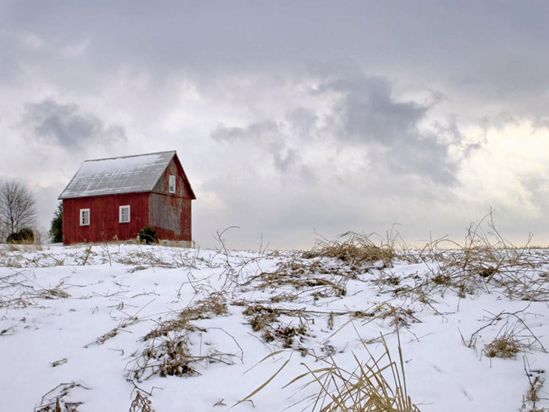
"Little Red Barn"
© Wendy Stevenson
Oxford Station, Ontario, Canada www.intoitphotography.com
This rustic red barn provides subtle color in contrast to the starkness of a snow-covered landscape and a gray, cloudy sky. Simple compositions are always more effective than cluttered ones, and this is very true of winter scenes. Also, be aware that the light snow poses a challenge to exposures. The camera meter is designed to record scenes with an 18-precent gray reflectance, which can underexpose the scene and turn white snow to gray. You'll probably want to give snowy scenes a tad bit more exposure than what the meter indicates. A snow scene on a sunny day may need an extra stop or two, while a dull day may require a half to one stop. Late in the day in very cloudy conditions like this may not require any exposure compensation at all.
"I have passed this little barn many times, but on this winter day, the sun was setting and very low on the horizon. I pulled my car over, climbed down into a ditch and set up my camera gear. I liked the way the red barn stood out against the whiteness of winter, as well as the texture of the snow-covered field and the beautiful diffuse light of the setting sun. I chose to shoot this scene from a low perspective — as I do in many situations — to keep the background clean and simple."
Canon EOS Digital Rebel XT
Canon EF-S 17–55mm f/2.8 zoom lens set at 22mm
1/2000 of a second at f/20
ISO 100
Late afternoon light on a cloudy day
This scene of volcanoes is awe-inspiring and otherworldly — and well worth getting up before dawn to arrive at such a dramatic vantage point at sunrise. It's also difficult to find a great (and safe) place to photograph volcanoes, particularly active ones. At high elevations like this, sunrise occurs later than if you were taking pictures at the beach. But either way, early morning light is warm and yellow, and the low light casts long shadows on the land, which accentuates texture. The mist at the base of the volcano in the foreground is beautiful as well. When photographing a scene like this where it's important to have all of the elements in sharp focus, use a small aperture for great depth of field.
"The Bromo Tengger National Park in East Java, Indonesia, is one of my favorite photo locations in the world. Starting from the crater rim village of Cemoro Lawang, a one-hour climb in the early morning darkness brings you to an amazing viewpoint. The scene here is always so primal — especially so if you catch it at sunrise. Mt. Semeru, the highest volcano in Java, spews ash about every 30 minutes and forms the backdrop. Sulphurous gases are always emanating from the foreground crater, Mt. Bromo. Early morning light highlights everything beautifully. What more inspiration could you ever want?"
Canon EOS D60 digital SLR
Canon EF 28–135mm IS zoom lens
1/5 of a second at f/11
ISO 100
Sunrise
"Volcanoes, Bromo Tengger National Park, Indonesia"
© Dennis Walton
Bellingham, Washington www.fdwphotos.com
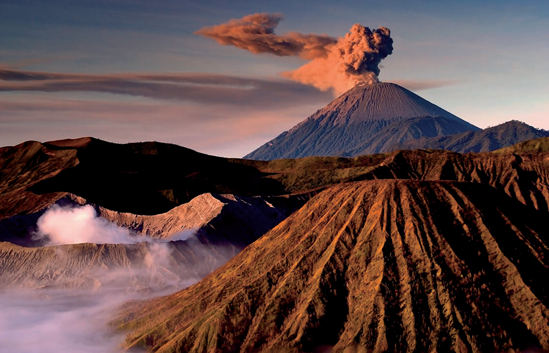
Early and late in the day, the raking light imparts texture, depth, and form to landscapes. This light, combined with the illumination immediately after a storm gives you outstanding photo opportunities, as the photographer demonstrates in this lovely mountain lake scene. The three boats that are docked on the shore also offer a visual clue that indicates scale, as well as providing some bright colors.
"After a full day of hiking under a cool blanket of rain and mist, the cloud cover broke. The early evening light lay across the landscape, showing its brilliant color against the otherwise gray horizon. Combined with the silent shadows of drifting clouds along the mountain range, there was a stillness that could only be captured with my camera and a bit of luck in being in the right place at the right time."
Nikon D70s digital SLR
12–24mm f/4.0 Nikkor zoom lens set at 12mm
1/60 of a second at f/16
ISO 200
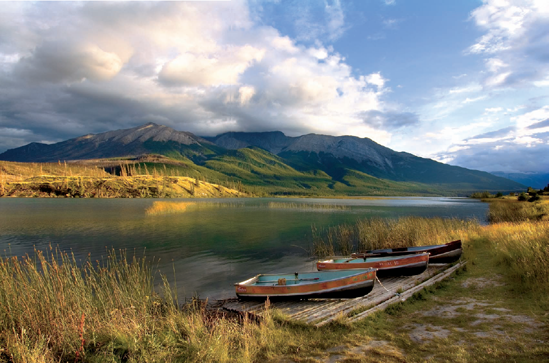
"Talbot Lake, Jasper National Park"
© Michael Bayer
Nova Scotia, Canada
This image definitely gives us the sensation of a plane circling the city below in preparation for landing. Doing aerial photography on commercial airlines is challenging partly because of the thick plastic windows that make sharp focus difficult, but you can minimize this fuzziness by getting your lens as close to the window as possible. Take-offs and landings are the best time to shoot, because the lower altitude makes features on the ground more recognizable and there's less atmospheric haze. This image also works well because the photographer focused on the plane's wing and the result is much like panning in action photography — the moving subject is relatively in focus while the background is a blur.
While traveling for work one summer (as I often do), I decided that in order to spend more time behind the lens, I would have to start requesting window seats on flights and haul the camera out of overhead storage. On a flight coming home to Harrisburg from Chicago, I began shooting long exposures of the city lights below and liked the sense of movement that I achieved. As we neared the airport on our descent, it dawned on me that without much air turbulence, I could probably hold the camera still enough with an IS (Image Stabilizing) lens to keep the wing in focus and allow the lights below to do their merry dance around it. 'Night Approach' is the happy result of that inspired experiment."
Canon EOS 20D digital SLR
Canon EF-S 17–85mm f/4–5.6 IS lens set at 17mm
1.3 seconds at f/4
Pattern metering mode and auto white balance
Minor adjustments to the white balance and levels and curves made in Adobe Photoshop
"Night Approach"
© Daniel G. Walczyk
Wrightsville, PA http://wystudios.photoworkshop.com
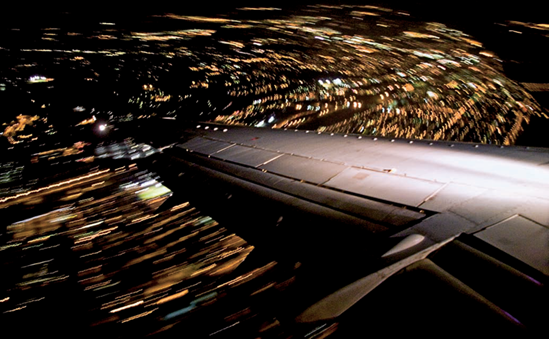

"Monument Valley Silhouette"
© Michael Cetta
Brooklyn, New York www.mikecetta.com
For anyone who loves shooting landscapes, Monument Valley's buttes and rock formations easily distinguish this Navajo Tribal Park from other wilderness areas. The silhouetted spires are very striking against the colorful pre-dawn sky. To photograph a silhouette, take a meter reading of a bright background — the sky, colorful wall, or perhaps the glittering ocean at sunset — and use your exposure lock to hold that exposure. This renders foreground shapes in silhouette. When looking for subjects for silhouettes, find ones that have bold and easily recognizable shapes for best results.
"I was staying at a hotel close to the entrance to Monument Valley on the Arizona side. I woke up at 5:30 a.m. and happened to look out the window at this incredible sunrise. The whole area reeks of mystery and haunting beauty, but this topped it all. So I grabbed my camera, went out on the terrace, and started shooting. The colorful sky was changing by the minute, so I just shot away. All I could think about was the conversation I had the day before with the Indian guide who drove me through the valley. He pointed out places and rock formations that Indian tribes experienced as mystical symbols. I was torn between shooting the scene and just taking it all in — it was easy to understand what the guide was talking about."
Canon EOS 1D Mark II N digital SLR
Canon EF 70–200mm f/4.0L IS lens set at 200mm
1/99 of a second at f/9.1
ISO 400
Spot metering
Natural light at sunrise
Mist is very effective in photography because it creates a lot of atmosphere, and as shown here, can render sunlight as dramatic beams when the sun breaks through. The photographer was in the right place at the right time to capture this wonderful light streaming through the trees. As I mentioned earlier, dramatic light can occur early or late in the day, or after a storm. On sunny days, beams of light can come in through high windows in cathedrals or other buildings designed for this phenomenon. Have your camera handy, as you may come across beautiful light when you least expect it. A wide-angle lens helps you encompass a scene with mist and the interesting lighting that it produces.
"Stanley Park, located in Vancouver, British Columbia, is a wonderful place to take pictures. I took this image on a typical late October morning where the cool fall air produces a thick mist over the entire countryside. When the sun rises, an incredible display of natural lighting effects takes place. On this occasion, I wanted to capture the unique way that the trees and mist were bending the sun's rays."
Canon EOS 20D digital SLR
Canon EF 24–70mm lens set at 24mm
1/80 of a second at f/7.1
ISO 200
Morning light
"Morning Rays"
© Michael Pickelsimer
British Columbia, Canada http://mpickelsimer.photoworkshop.com
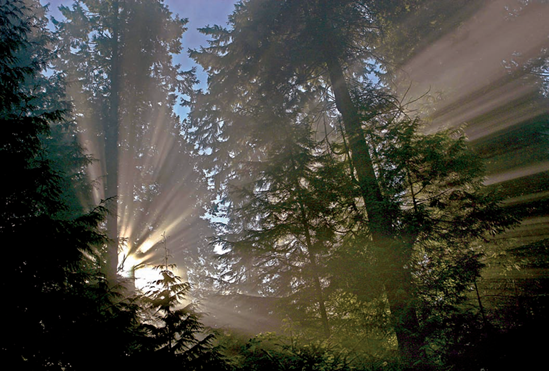
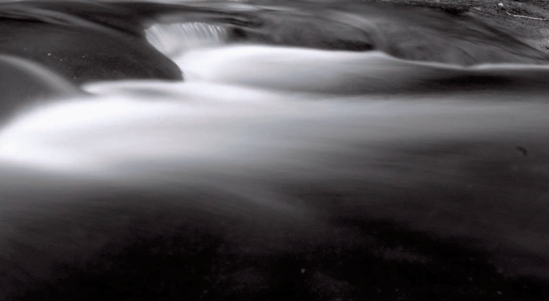
"Quillion Creek, Bankhead National Forest"
© Cynthia McKinney
Decatur, Alabama http://cynthiamckinney.photoworkshop.com
Many people choose to freeze the action of rushing water by using a fast shutter speed. But this photographer chose to render the water as soft and dreamy by using a long exposure. She also used a neutral density filter to allow less light into the lens, enabling her to use a slow shutter speed of several seconds. The image makes a statement about the peacefulness of nature. She also chose a low vantage point to emphasize the silky feeling of this small waterfall, and I like the way that the white water fades into the dark shadows. The composition is very simple, and extraneous elements are eliminated.
"This is a small waterfall on Quillion Creek in Bankhead National Forest. This area of the forest is calm and peaceful, where one can find a quiet moment to reflect. I was inspired to shoot this image while sitting along the creek's edge one day. I looked at the waterfall thinking about the black rock and quickly flowing water, and knew that it would make a great black-and-white image. I set up the camera on a tripod and looked through the lens. That's when I noticed that the waterfall looked like a set of angel wings."
Canon EOS Digital Rebel
Tamron 28–300mm zoom lens set at 28mm
15 seconds at f/22
#6 Neutral Density filter
Monfrotto 3001BD tripod with a 3030 Manfrotto head
Changed the color to black-and-white in Adobe Photoshop CS
A rainbow sighting is awe-inspiring for nearly everyone, even the most jaded among us. It's difficult to predict where a rainbow will appear, but you increase your chances of seeing one by facing in the direction of a dark sky, in the opposite direction of the sun after a storm. This photographer also included an interesting foreground in the scene, giving the image a sense of scale. It's more interesting than simply photographing a rainbow hanging in the open sky. You can also use a polarizing filter to intensify the colors of a rainbow (just be sure you don't rotate the filter in a way that eliminates the rainbow altogether).
"It was 6:16 a.m. on St. Bartholomew in the French West Indies, and I had just awakened at the rental house where I was staying. My Canon 5D was upstairs, and I knew that the rainbow would be gone before I could run and get it. Because I always try to keep my little Canon point-and-shoot with me, I fired off two shots, locking the exposure on the left frame image, with about a 30% overlap. Five minutes later the squall had passed and it was sunny outside. I then manually stitched the image together in a software program called Ptgui and output the maximum size that was possible −3504 × 1676 at 240 dpi."
Canon PowerShot SD800 IS compact digital SLR
1/250 of a second at f/7.1
ISO 100
Natural light
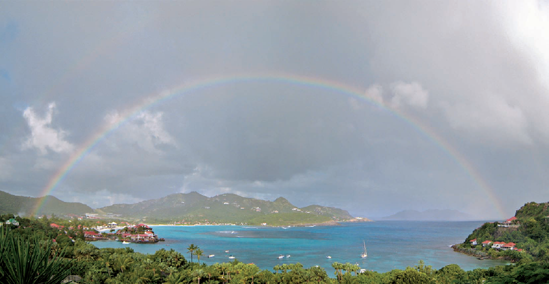
"Morning Beckons"
© Rice Jackson
Austin, Texas www.terra360.com
This image is a testament to the fact that simple compositions are best — a good photograph should reveal a simple subject or idea with as little clutter as possible. Paring your compositions down to the most basic elements begins as a mental process. You need to decide what your subject is and figure out the best way to focus attention on it. There is no question in this photo that the tree is the subject, but the photographer has taken it a step further by portraying it as a lonely figure. Its bare branches against a cloudy sky further accentuate this statement. Color may have contributed to the mood of this photo, but the choice to render it in black-and-white adds to the bleakness of the scene.
"I enjoy taking pictures of trees; I feel that they show human emotions. This particular tree is located in Valley Forge National Park. I was feeling very much alone at the time. My husband had moved to Cleveland, Ohio to open an office and my son was also away. When I saw this tree, it reminded me of how I felt at that moment, and it seemed as though it must also be feeling lonely in that field."
Canon EOS Digital Rebel SLR
Canon EF-S 18–55mm f/3.5–5.6 zoom lens set at 55mm
1/500 of a second at f/16
ISO 400
Natural light on an overcast day
"Solitary Tree"
© Cheri Homaee
Richfield, Ohio www.trinityconsult.com
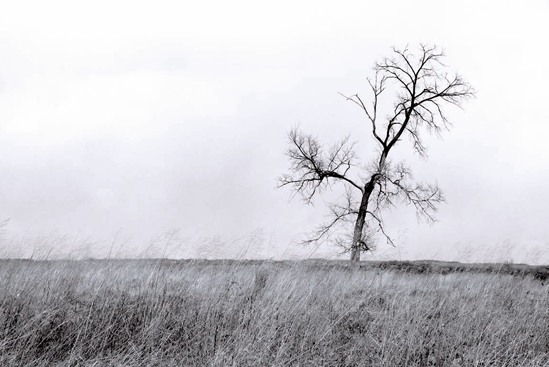
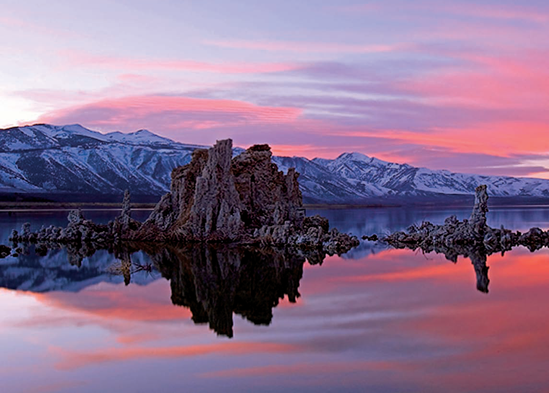
"Lake on Fire"
© Richard Aksland
Manteca, California
This image not only depicts a beautiful sunset, but the dramatic tufas that distinguish northern California's Mono Lake offer a sense of time and place. The fiery sky, as well as the lake's unique calcium-carbonate spires, is reflected in the calm water. The foreground elements would have been depicted beautifully as silhouettes, but this photographer was able to expose both the foreground and colorful sky equally well. This can be done by using a graduated neutral-density filter, which balances the exposure for the land and sky so that you'll get detail in both parts of the image.
"I had been to Death Valley, California, to shoot some photos at the "Racetrack." This was my fourth trip and each time, the weather didn't cooperate. While I was returning home on Highway 395 I noticed the clouds accumulating over the mountains. I was just south of Mammoth Lakes and was heading toward Mono Lake. I thought, 'this sky could really pop when the sun sets.' I picked up my pace and the closer I got to Mono Lake, the better it looked. But I knew there was a chance I may not make it in time. As I pulled into the parking lot, the sky took on an orange glow. I quickly gathered up my gear and ran down to the shore. I set up my camera and tripod, and got three pictures as the sky turned this brilliant shade of red — then it was gone."
Camera 20D digital SLR
Canon EF 24–70mm f/2.8L lens
1.3 seconds at f/22
ISO 100
Tripod
Ambient light at sunset
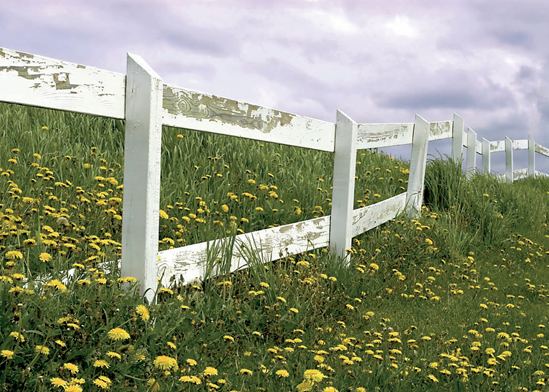
"Fence Line"
© Wendy Stevenson
Oxford Station, Ontario, Canada www.intoitphotography.com
When shooting landscapes, look for an element that will lead the viewer's eye into the image. This fence creates a pleasant leading line that meanders across the frame. Lines can be used to create a sense of depth, or to lead a viewer's eye to the main subject. In this case, the fence is the subject, which leads our eye from the left to the right side of the picture. Other subjects for leading lines could be a road curving off into the distance, or the graceful S-curve of a river. When looking for lines to photograph, observe how they work with each other, since this interaction can add to the tension the photo captures. Here, the weathered fence provides contrast between the cloudy sky above and the grass and flowers in the lower portion of the frame.
"I was driving around and almost headed home because of an impending storm rolling in. The skies were filled with heavy clouds when I came upon this rickety fence with a lot of peeling paint at a local golf course. It was on a dandelion-covered hill. The grass hadn't been mowed yet and the sky was very dramatic. I really liked the limited color palette, the different textures, and who doesn't like bright yellow dandelions?"
Canon EOS Digital Rebel XT
Canon EF 50mm lens
1/125 of a second at f/22
ISO 100
Afternoon light on a cloudy day
After a rainstorm, landscapes often look fresher, cleaner, and colors are deeper. If you are in an urban area, the best time to photograph city lights is often after a good downpour clears the air of smog and haze while leaving the city glistening. In rural areas barns often look redder and grass greener. And, on the ocean, colors are darker and richer providing a nice contrast against white caps and blue seas. Remember that because of the Rule of Thirds, objects are more pleasing to the eye when placed off center.
"I was on the coast of Oregon for a week and took photos of this sea stack, affectionately called "the Dragon" by locals, every day. Of all the photos I took — sunsets, midday, and so on — this is my favorite. A downpour had just drenched the area and the skies were a deep blue in the late afternoon when I took this photo. The colors of the sand and rock were richer and more saturated after the rain gave everything a good soaking and I love the moody feeling that was captured."
Canon EOS Digital Rebel XT
Canon EF 28–80mm 1:3.5–5.6 zoom lens
1/2000 of a second at f/7.1
ISO 100
Natural light
"The Dragon"
©Cricket Krengel
Pendleton, Indiana
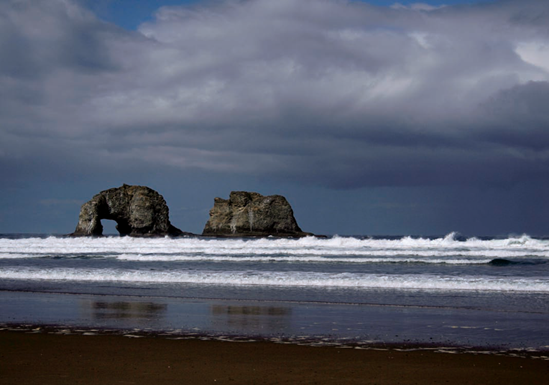
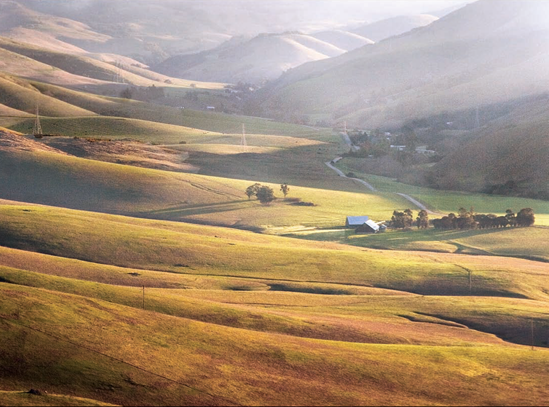
"East of Black Mountain"
© Eugene Langer
Sacramento, California
A successful landscape image should capture the mood and spirit of the place. Before shooting pictures, ask yourself what it is about the scene that appeals to you emotionally. Here, the photographer captured the serenity and cool greens of these rolling hills. A farmhouse in the right third of the photo also offers scale to the image. For me, the overall feeling of this pastoral scene is that of peacefulness and calm.
"While I was in Morro Bay on a crisp March morning, I took a short hike up the hill behind the golf course(Black Mountain), set up my camera and tripod facing west, and like most photographers, began taking pictures of Morro Rock. I took a few shots and decided to add a filter. I turned to get the filter out of my camera bag and shazamm! There it was — a quiet little farmhouse nestled among rolling hills of green and gold. The peace and tranquility of the scene might lead one to think of Kentucky or perhaps Tennessee. But I double-checked, and Morro Rock was still there. I thought, 'yep, this is California all right.' I think the most important aspect of this shot — as with many of my photos — is serendipity."
Canon EOS 20D digital SLR
Canon EF 28–135mm f/3.5–5.6 IS zoom lens set at 90mm
Gitzo 2227 Tripod with Really Right Stuff Ball
Head D55
1/200 of a second at f/9.0
ISO 100
Early morning light
This beautifully composed scene makes a strong statement about winter. Color adds much to the mood of a photograph, and the blue tones of this image underscore the stark, dead-of-winter feeling in this scene. It's almost a monochromatic study of white and blue-gray. I also like the texture created by the delicate tree branches in the background, and the way that this texture is echoed in the reflection below. If you often visit an area with some regularity during all times of the year as the photographer does this one, consider photographing the same scene in fall, winter, spring, and summer to create a series of memorable images.
"The place where this image was captured is not far from my home. It is an oasis of nature surrounded by the hustle and bustle of urban/suburban life. Because it is close by, I visit there often during the various seasons, as I find it to be a place of natural beauty and peace. What caught my eye were the tree limbs reaching out of the cold, semi-frozen water, as if frozen in time. I also liked the patterns of the reflections in the water, as well as the contrast of the tiny, fragile branches against the heavier, stark tree trunks. I altered the color to blue in Adobe Photoshop, as I felt that this was appropriate for the mood of the picture."
Sony Cybershot compact digital SLR
Built-in zoom lens set at 30mm
1/125 of a second at f/2.5
ISO 100
Available light
"Reflections in Blue"
© Marian Rubin
Montclair, New Jersey http://marianrubin.photoworkshop.com
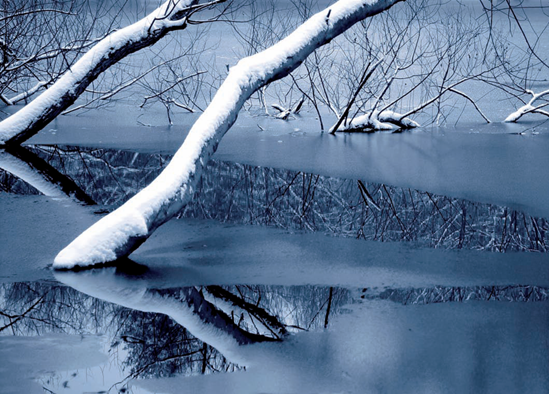

"Red Mountains, Ouray, Colorado"
© Ricardo Reitmeyer
Wichita, Kansas www.ricardoreitmeyer.com
This beautiful panoramic view of the Rocky Mountains in Colorado celebrates what's beautiful about mountain scenery — jagged peaks, a variety of terrain, and contrasting colors and layers that result from numerous minerals in the soil. This photographer successfully portrayed the majesty of these mountains, and the sun peeks through cloudy skies and makes for very dramatic light. When you encounter a situation such as this — one can only truly be represented by a panoramic image — keep the camera as level as possible (or use a tripod if you have one handy) and take multiple images, overlapping each slightly, to capture the entire expanse. You can stitch the images together using one of several different software programs.
This scene says it all about mountain views. I took a long jeep tour up a very rough jeep trail with my family, led by a very professional local Ouray tour guide, to the top of Imogene Pass, hoping for this amazing view at the summit. Sometimes the challenge is just being there at the right time with the right conditions. The Red Mountains are rich in iron ore and have 'rusted' over the years, creating this marvelous coloration. It was a normal, handheld series of two photos stitched together in Adobe Photoshop that created this beautiful panoramic scene of the mountain range from a 'cloud bottom' altitude. The incredible layering of the San Juan mountain peaks in the distance adds to the depth of the view."
Canon 20D digital SLR
Canon EF 28–105mm f/4.0–5.6 zoom lens set at 38mm
1/125 of a second at f/8
ISO 100
Pattern metering mode
Natural light
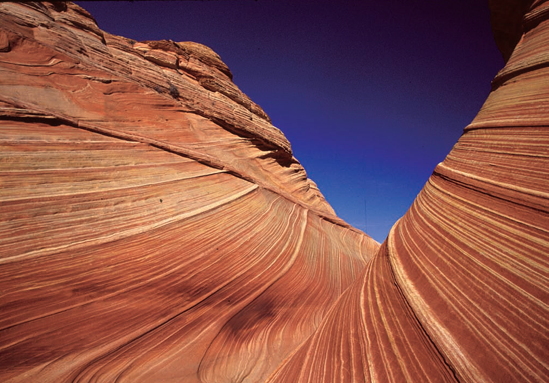
"The Wave"
© Lynne Eodice
Altadena, California
When planning to shoot in areas you have not been to or are not familiar with, it's best to do research in advance via travel guides or the Internet, and find out when is the best time of day (and time of year) to photograph your destination — especially in the desert southwest where this photo was taken. You may want to narrow down your shooting to a few specific ideas. For example, there's usually specific geographic features that identify a particular region, such as the rocky arches of Arches National Park, the stone pillars of Monument Valley, and the sweeping lines of 'The Wave' at Coyote Buttes North.
"After seeing photos of 'The Wave' at Coyote Buttes North in the Vermillion Cliffs Wilderness, I was determined to go there one day. As this area is under the auspices of the Bureau of Land Management, visitation is limited and by permit only. My husband and I were finally able to get a permit for January about six months in advance. The weather was cloudy and dull as we drove to southern Utah the day before our big excursion, and I was very disappointed. Rescheduling our visit wasn't an option. Thankfully, the sky was clearing when we awakened before dawn the next day. The low angle of the winter sun provided great illumination, and hiking to The Wave was an adventure as well. I was fascinated with the wavy texture of the rock, which gives this beautiful natural area its name. I was standing near the center of the relatively small area that comprises The Wave, and enjoyed photographing these lines leading toward the center of the frame, as well as the blue of the sky against red rocks."
Canon EOS-3 35mm SLR
Canon EF 28–105mm f/3.5–4.5 II zoom lens set at 28mm
Kodak Ektachrome E100VS transparency film
1/125 of a second at f/8
Tiffen circular polarizing filter
Bogen 3001 tripod
Canon RS-80N3 cable release

"Palo Verde #1"
© Carol Watson
Austin, Texas http://carol_watson.photoworkshop.com
Black-and-white infrared images look as though they were taken in eerie moonlight, as evidenced by this ethereal scene. The illuminated white tree appears to be full of life, even though its leaves are gone and it looks as if it's in a dormant, wintertime mode. Vegetation becomes white because chlorophyll reflects a lot of infrared, but the sky darkens because it absorbs infrared rays. The late-afternoon light rakes across the land in this image, resulting in haunting feeling. The dark sky with the contrasting pale clouds are very dramatic too.
"During a trip to Phoenix, Arizona, I accidentally happened upon an indigent cemetery gate and it glowed a warm, green color in the golden light of the day. I chose to photograph the tree using digital infrared techniques. The infrared-rendered contrast created by the surrounding dramatic sky symbolized the darkness often associated with death. Still, the bright green branches of the tree reflected a bright white warm glow, which captured a sense of hope and symbolized the fond memories of love that lives on forever after death."
Sony DSC-F828 Cybershot digital SLR
Carl Zeiss built-in zoom lens set at 10mm
1/30 of a second at f/2.2
ISO 160
Hoya R72 infrared filter
Natural late-afternoon light
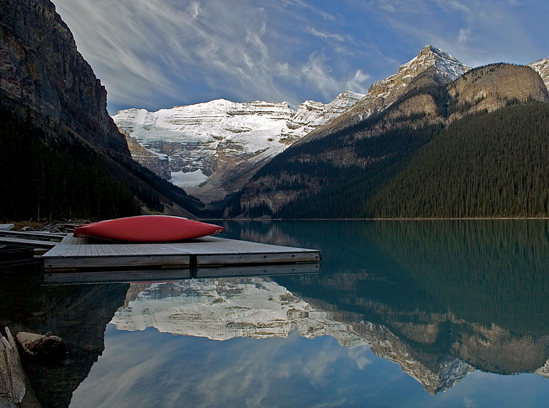
"Morning Light on Lake Louise"
©Michael Pickelsimer
Vancouver, BC, Canada http://mpickelsimer.photoworkshop.com
On a calm day, any sizable body of water can become a large mirror, reflecting perfect images of the surroundings. Water is most reflective when the sun is low in the sky early in the morning (especially just after dawn), or late in the day. I really like the mountain grandeur reflected in this lake, and the peaceful feeling I get by looking at this photograph. The canoe on the left side of the image offers a sense of scale and indicates the magnitude of the majestic Canadian Rockies in the background. It also adds a bit of unexpected bright color to the otherwise muted hues of nature.
"I wanted to capture the splendor of Lake Louise at sunrise. The image was taken early on a clear, cold morning when there wasn't a breath of wind. The entire area was incredibly quiet and still, which allowed the mirrored surface of the lake to frame the composition. The morning sun provided the perfect backdrop for the frosty deck as the warm light began to bathe the glacier."
Canon EOS 20D digital SLR
Canon 18mm wide-angle lens
1/60 of a second at f/5.6
ISO 100
Circular Polarizing Filter
Natural light at sunrise
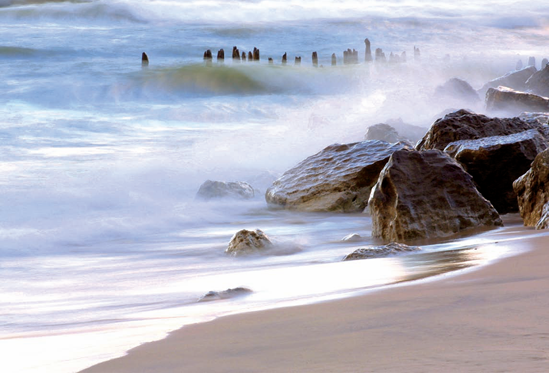
"On the Rocks"
© Tom McCall
Saint Joseph, Michigan www.phototown.com
Brief time exposures freeze the action of the waves, and can accentuate the power of the sea. On the other hand, long exposures ranging from 1/4 to several seconds impart a smooth, glossy sheen to the shore and rocks. I really like the photographer's choice of shooting this scene with a one-second exposure, which creates a beautiful impressionistic blur. The softness of the water also provides a very effective contrast to the jumbled rocks and the pilings beyond.
"Taken just before sunset, it was seeing the interplay of the quality of light with the natural elements of wind, waves, sand and rocks, the old jagged wooden pilings, and the light and shadows all coming together with a slow shutter speed and small aperture to capture an ethereal effect. I watched the crashing waves wash over the rocks with the wind catching the spray. The water quickly returned to the lake, creating fleeting moments that revealed reflections of color from the rocks and sky. The long exposure of the spray and waves creates a mist that floats like a blanket of fog over the water. I feel fortunate to have been able to photograph it when I did. Soon afterward, storms and strong waves removed all the sand, and this location has a totally different appearance."
Canon EOS 30D digital SLR
Canon EF 75–300mm f/4–5.6 zoom lens set at approximately 200mm
1.6 seconds at f/36
ISO 100
Natural light late in the day
Images of the open highway always inspire me to take a road trip. The lonely road in this photo leads the eye into the frame, and I want to travel on it to see what's beyond the vanishing point. The storm clouds add a lot of drama — this scene would be somewhat mundane if it were shot in the middle of the day in sunny, calm weather conditions. The grass blowing in the wind warns of a storm that's either approaching or receding.
"This photo was taken in Connemara, Ireland, on the road going to Clifden by the seaside. I was there with my students (I'm a teacher) and asked the bus driver to stop the bus for a while on that deserted road. The sky was heavy from the rain, but it started to clear up and it was very windy. I took this picture because the landscape was amazingly beautiful and wild, and that deserted road gave a feeling of endlessness to the scene. I've always like taking pictures of deserted roads in nature because they represents freedom, adventure, mystery — and somehow — the loneliness of mankind among nature."
Fujifilm FinePix 7000 digital compact camera
Super EBC Fujinon lens with an optical zoom
1/180 of a second at f/2.8
ISO 200
Natural light
Sepia-toned the image in Adobe Photoshop
"Connemara"
© Sandrine Huet
Juvisy, France http://cendrynneh.photoworkshop.com
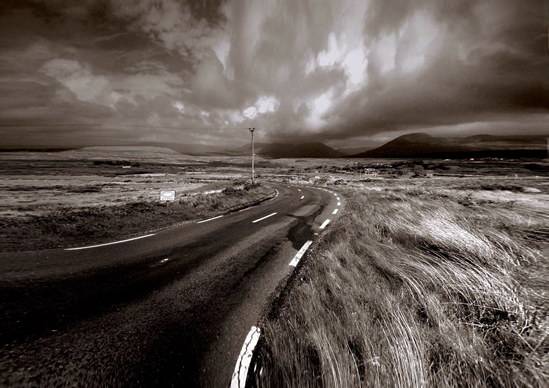
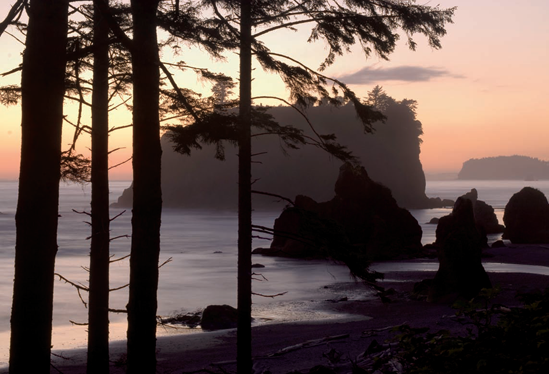
"Sunset at Ruby Beach"
© Doug Bascom
Bellingham, Washington www.dbascomphoto.com
You can create some beautiful images of rocky shorelines, such as those found along the Pacific Northwest. A wide-angle lens allows you to capture a lovely array of dramatic standing rocks as the water gently comes to shore during low tide. This image, photographed very late in the day, features soft, pastel skies as well as silhouetted rocks and trees. A long exposure gives the appearance of water softly enveloping the rocks, rather than a brief exposure of crashing waves.
"It was the end of a full day of taking pictures on the Olympic Peninsula in Washington, and I stopped to look back at the area from which I had come. I was struck by the beauty of the light and the design elements that the trees provided."
Canon EOS 20D digital SLR
Canon EF 24–85mm f/3.5–4.5 zoom lens
10 seconds at f/22
ISO 100
Natural light late in the day
A beautiful waterfall is always a visual treat for nature photographers, and the cool blue color palette in this photo is especially soothing. On a hot day, you'd want to jump right in. As with several other water images in this section that utilize long time exposures, you should select a slow ISO (100) and set your camera up on a sturdy tripod. To render the water with a soft look, you should use a shutter speed of one second or longer. Using a neutral-density filter cuts down on the light entering your lens in bright-lighting conditions, which allows you to use longer exposures.
"This photo was taken at Westfield Falls near our former home in Middletown, Connecticut. We lived there for 18 years and drove by but never had a chance to visit the falls. This is one of those places you take for granted because you live so close and think that you'll get there, but never get the chance to stop. We have since moved away and often speak of having missed the opportunity to visit this landmark. I stopped one day and took this picture so I could show my wife what we had missed for so many years. Now we take the time to stop and visit the falls to watch the water on a regular basis."
Canon EOS 20D digital SLR
Canon EF 28–135mm f/3.5–5.6 IS zoom lens set at 80mm
1 second at f/10
ISO 200
Cokin #80 cooling filter and circular polarizing filter
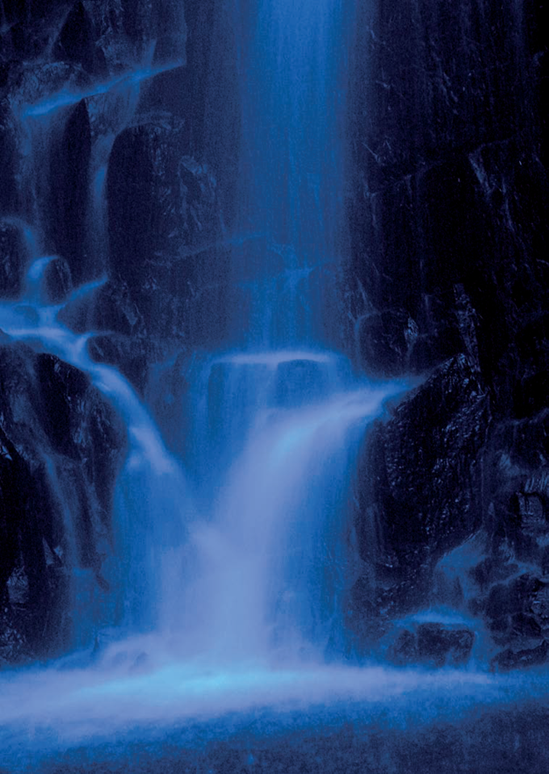
"Blue Falls"
© Steven D. Handley
Meriden, Connecticut
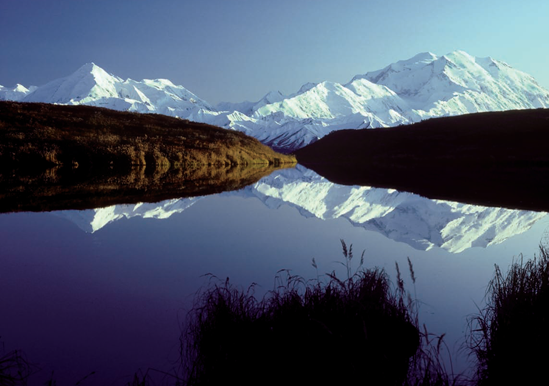
"Mt. McKinley"
© Victor Van Keuren
Bar Harbor, Maine http://victorvankeuren.photoworkshop.com
The low light of dusk and dawn give mountain images depth, texture and three-dimensional form. This scene would not have been nearly as dramatic if it had been photographed at midday. A polarizing filter deepens blue skies on a sunny day, and can accentuate reflections in water or other reflective surfaces. The calm conditions rendered this mountain lake as a huge mirror that reflects the mountain majesty surrounding it. And at very high altitudes late in the day, you may experience a special phenomenon known as "alpenglow." This occurs when blue light is scattered by the atmosphere and warm light briefly infuses the peaks with a radiant glow.
"This shot was taken while I was traveling along the Denali Park Road in Alaska. As sunset approached, I found myself in an area dotted with tundra ponds. It was an unusually clear day with no wind, which made for perfect reflections. I shot about 150 exposures in 90 minutes with various degrees of alpenglow on the mountain. After dark, the northern lights came out for an incredible display. It was three hours of visual feasting!"
Nikon F4 35mm SLR
50mm f/1.2 Nikkor lens
Kodak Kodachrome ISO 64 film
1/60 of a second at f/22
Polarizing filter
Tripod
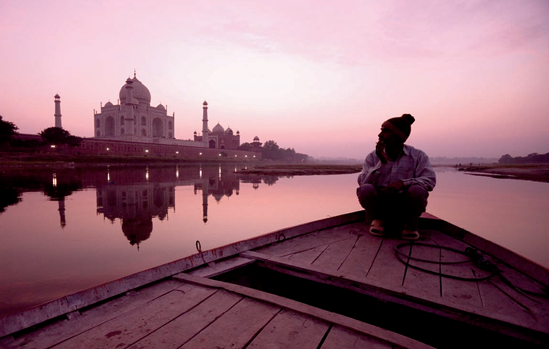
"Taj Mahal-River View"
© Marcin Kizior
Dublin, Ohio www.marcinkizior.com
Photographing people in distant lands adds interest and a human element to often-photographed scenes. The owner of this boat gazed off in the direction of the Taj Mahal, providing the photographer with the opportunity to capture an outstanding travel image. Many people like to take vacation pictures of people smiling stiffly at the camera, but you often get better results if you shoot more candidly. Take pictures of people enjoying the scenery or participating in an activity. Also, unless you really need to use flash in dimly lit scenes, try to shoot with the existing light as the photographer did here. Nothing ruins the spontaneity of a moment like an electronic flash being fired.
"I had seen a lot of photos of the Taj Mahal, and most of them were similar. I wanted to get some unique images, but didn't have anything specific in mind. I knew there was a way to photograph this icon from the outside, and found someone to take me there by boat. It was getting late and the sunset was nearly over, so I wanted to get to the other side of the river ASAP. I inquired about the price, but because it was getting dark and the guy saw all my photo gear, there wasn't any room for negotiation. I adjusted my camera settings before I got aboard, hoping for a shot from the river. I shot one image of the Taj Mahal alone, and turned around to see the owner of the boat looking at the Taj Mahal. There was no time to check the settings on my camera — just focus and shoot — and then the moment was gone."
Canon EOS 5D digital SLR
Canon EF 16–35mm f/2.8L zoom lens set at 16mm
1/60 of a second at f/4.5
ISO 1000
Ambient light at dusk
"Beach Outlet"
© David Amos
Woodcroft, Australia www.davidamosphotography.com.au
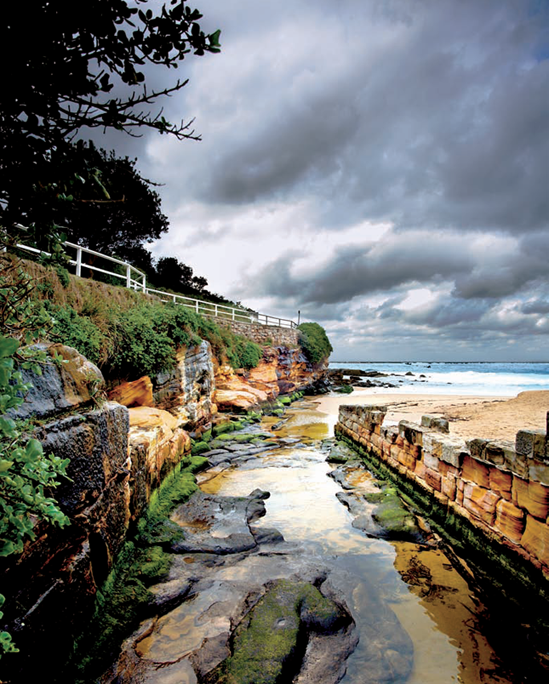
Shooting pictures at the beach is always fun, but presents a special set of challenges. Shot with a wide-angle lens, this scene offers a variety of textures ranging from the rocks along the coast to the reflections in the water, and finally, the dark, brooding sky. This photo also has leading lines that take the viewer's eye to the center of the picture. The colors in the scene are saturated and rich, which is one advantage of shooting on a cloudy day.
On a weekend away with my wife, I had no plans to photograph any particular scene. While walking along the beach, I came across this view of a storm water outlet into the ocean. I liked the way the lines were converging, as well as the color contrast between the land and dark clouds in the distance. Also, the reflection in the water is always an attraction for me when shooting landscapes. I shot two photos with different exposures to keep the clouds in detail and the dark foreground. I combined the two exposures for a wider dynamic range in the scene."
Canon 5D digital SLR
Tokina 19–35mm zoom lens
1/125 of a second at f/5.6
ISO 100
Natural light
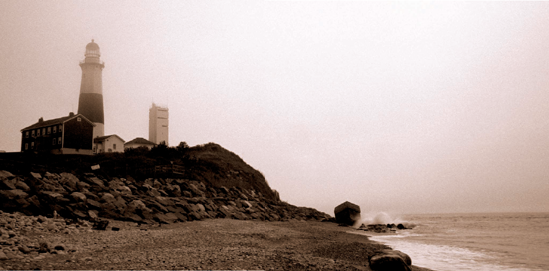
"Lighthouse in Fog"
© Ricardo de Masi
East Northport, New York www.rdmphotography.com
Photographic subjects often take on a diffuse, gauzy quality during foggy conditions, and hues are muted. You can simplify your images in fog, as distant objects fade off into the pale background. Depending on how heavy the fog is, you'll get varying results. In this image, the fog appears to be a light morning mist as opposed to a thick cloak of haze. The lighthouse and the dark foreground stand out nicely against the light sky, and the mood is further emphasized by the image's sepia tone.
"On my first wedding anniversary, my wife and I decided to spend a few days out on the east end of Long Island to sightsee and enjoy the island before summer began. One morning, we went to Montauk Lighthouse to get what every Long Island photographer needs in his/her portfolio — pictures of the Montauk Lighthouse. Foggy weather was not what I had hoped for, but once we got to the beach, I saw the lighthouse standing proud in the fog. This was something I hadn't seen before, as this lighthouse is usually photographed on clear, sunny days. So I shot several rolls of film and ended up with this one."
Nikon N70 35mm SLR
Nikkor 12–120mm zoom lens
Ilford Pan F ISO 50 black-and-white film set at ISO 40
Exposure unrecorded
Tripod
Natural light
Sepia tone added in Adobe Photoshop
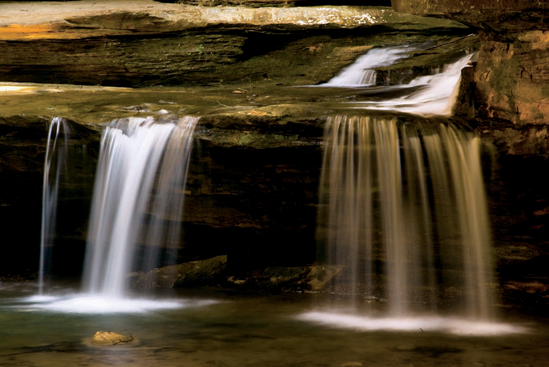
"Waterfalls at Old Man's Cave"
© Daniel Walczyk
Wrightsville, Pennsylvania http://wystudios.photoworkshop.com
Moving water has a very soothing effect on people, so it's no wonder that rivers, streams and waterfalls are among the favorite subjects of landscape photographers. To get the effect of a silky, flowing veil that you see here, put your camera on a tripod and use a long time exposure. The amount of time it takes to blur the water varies, but generally, use exposures ranging from 1/4 second to four seconds.
"After receiving word from the North American Nature Photographer's Association about the Friends of Hocking Hills State Park 'Shoot the Hills' photo competition, my partner and I decided to participate. Over 150 photographers competed in five categories in each division: abstract, flora, human interest, landscape, and wildlife. I shot this image to see if I could satisfactorily achieve the wispy, ethereal look that's often seen in images of waterfalls. In the end, I didn't submit this photo to the competition, because I thought there would be as many waterfall images as photographers competing. As it turned out, there were only a handful of moving water images and two received honorable mentions."
Canon EOS 20D digital SLR
Canon EF-S 17–85mm IS zoom lens set at 85mm
3.2 seconds at f/32
Available light in forested area
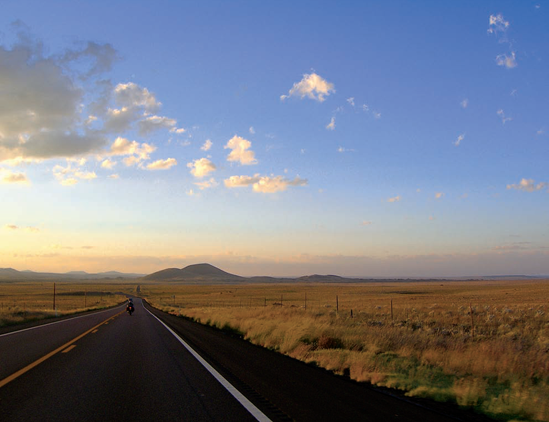
"The Road #4"
© Susan Duckworth
Waverly, Pennsylvania http://susan_duckworth.photoworkshop.com
There's nothing like an image of an open highway, which always inspires me to take a road trip. The leading lines of this road take our eye to the horizon line and the sun's last glow. The photographer has also wisely placed the horizon low in the frame, which adds emphasis to the beautiful sky and sunset-illuminated clouds. But no matter where you decide to place the horizon in a scene, be sure to keep it level. There are few things more distracting than an accidentally sloped horizon line in landscape photos.
"I took this photo from the back of my husband's BMW K1200RS while we were on a cross-country trip from Pennsylvania to California. He was going to participate in an annual BMW-sponsored charity ride for St. Francis Children's Hospital's Footsteps program. We had just stopped in New Mexico to pick up a friend. Toward the end of the day, as we headed west through New Mexico toward Arizona, I saw this scene and snapped a photo. Our friend liked the image so much, he had it blown up into a mural and it's on the wall in one of his BMW dealerships in Albuquerque, New Mexico. I used the Casio because I knew it would be a long day with possible inclement weather, and I didn't want my Canon camera out in the open. But the little Casio point-and-shoot did a nice job!"
Casio EXZ750 compact digital camera
Speed priority setting

"Blue Sky"
© Richard Roberts
Mesa, Arizona
This photographer used a wide-angle lens to capture this beautiful panoramic view of the Andes Mountains. Stormy weather adds atmosphere to landscape scenes, and the early morning light on these clouds is very striking. If you're willing to brave the elements during inclement weather conditions, your efforts will be greatly rewarded, as was the case with this image. As a storm approaches or departs, cloud formations can be very dramatic. Whatever you do, however, make sure to protect your camera from the elements by keeping it under your raincoat or umbrella.
"This is a very early morning view of the Andes Mountains. It was taken while I was on a fly-fishing trip to the Estancia El Palenque, which is at the southern end of what's known as Patagonia's "lake and river district." The weather was stormy at intervals, and while the others were still sleeping, I got up and went outside to watch the clouds and the light on the mountains. It was my first trip to the Patagonia area of Argentina, and I was in awe being in the presence of the Andes. To say the least, it was a memorable morning."
Fujifilm FinePix S2 Pro digital SLR
Tamron 28–75mm f/2.8 zoom lens
1/180 of a second at f/2.8
Camera was handheld
Natural light
A prediction of rain doesn't always mean that you need to put your camera away — stormy skies often present dramatic photo opportunities. You'll get the best results by photographing storms as they approach or while they're clearing, as you'll have the opportunity to capture beautiful lighting conditions. The rays of sunlight piercing through the clouds are what make this image spectacular. The photographer also succeeded in accentuating the vastness of the sky in proportion to the land below.
"This shot was taken during an early morning in October on the northern coast of Kri Island, Raja Ampat, Papua Barat, Indonesia. The Raja Ampat Islands are among the most fantastic and interesting skin diving locations in the world. When I wasn't diving in the ocean, I discovered that the Raja Ampat sky is the most beautiful one I've ever seen, with its dramatic light, nature's colors — and the clouds! I fell in love with them."

